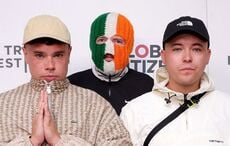Fashion can be acquired, but style is something you’re born with - just ask Simon Doonan.
Now a sprightly 55 year-old, he describes himself as a lucky man. “You should be wildly worshipful of me because I’m doing something I actually enjoy. A lot of my colleagues work for the money and they make a huge amount more than I do. But I’m the one that gets to have the chuckles,” says the creative director at Barneys, New York.
Today he’s revered in the world of high fashion, but he comes from a humble background. Born in Reading, England, in a distinctly working class suburb, he grew up in a two-roomed walk-up with no kitchen or bathroom. His parents, he says, met in a soup kitchen at the end of the war. Not an ideal background for a high-spirited boy who liked to dress up in drag and was fascinated by floral prints.
Doonan’s darkly funny memoirs, which stemmed from a weekly column for The New York Observer, have been made into a BBC sitcom called "Beautiful People." “I called my memoir 'Nasty: My Family and Other Glamorous Varmints' because, I find, you remember the really hideous things first, don’t you? You can remember the time that you took your blind aunt Phyllis out for a walk and let her slam into a lamppost because you weren’t paying attention. Then you’re consumed with guilt. It’s not a whiney book, I made a deliberate attempt to celebrate the richness of my family and the humor.”
The son of Irish parents, Doonan learned early on that in England in the 1950s being Irish meant being second-class. But his family, and especially his mother Betty, always had style. From Belfast, she became an electrician during World War II, the only woman in a hanger full of a thousand men. “She was the original Rosie the Riveter,” says Doonan.
“Every summer without fail we would pack up and get on the bus and head up to Liverpool for the boat over to Belfast, where we’d spend the summer with my granddad in Bangor. My mother was born in Bangor in 1918 and she left school at 13. She was very tough and very smart, a self-invented person. She was one who made her own way, she was an inspiration to me.”
That independent streak was inherited by her son. “I have pictures of me and my best friend Biddie Biddecombe at the age of ten and we’re both wearing full on drag. And I know that my mother took those pictures, she was a little eccentric like my other relatives. Her instructions were to me were basically don’t become a heroin addict or end up in a loony bin like a lot of my relatives.”
That eccentric family background actually prepared him for the life of glamour that he dreamed of in London. In 1973, he and his childhood best friend Biddie set off for London.
“I didn’t have a fabulous career in London I just had a job," he explains. "So when a lot of young kids come to me now and ask how do you do it, how do I get to be you? I just tell them get a job. Work hard and don’t worry too much. Go to Macy’s and get an entry level job and stop bothering me.”
In the 1970s during the punk era, Doonan dressed upscale fashion store windows with coffins and stuffed rats (wearing rhinestones and tiaras) and quickly he started to get recognition. Then an offer of a job and a green card to the U.S came up, which he accepted immediately.
“Living in L.A was fun,” says Doonan. “I was just 25. When I see Britney Spears and some of these girls carrying on now I remember I was very like that myself. Only minus the fame and all the money. We’d stop at the beach and take all our clothes off and go swimming because it was hot. The difference was there were no paparazzi following us everywhere?”
Doonan has always been a champion of uncompromising self-expression, particularly when it comes to what he calls “wacky chicks,” the girls who blow a raspberry at social expectations and usually get away with it. “I think Ireland has more than its fair share of self-invented women, women who have faced discrimination. Irish women like my mum can make other women look a bit insipid.”
In his latest book "Eccentric Glamour: Creating an Insanely More Fabulous You," Doonan offers what he calls “a defense against the tidal wave of slutty dressing and porno-chic which has been engulfing us since the arrival of Paris Hilton, Anna Nicole Smith, may she rest in peace, and Tara Reid.”
Doonan believes that the real pathway to a more insanely fabulous you means recognizing that your own unique personal style is your birthright. It means understanding and magnifying the core of your individuality, all the things that make you yourself, and not parroting the latest look in the celebrity rags.
“You need to stop trying to understand fashion and just understand yourself. Use clothes and style as a form of self-expression and don’t worry about being in or out or whatever. Clothes are non-verbal communication. Carrie Bradshaw is a very good example of eccentric glamour, Pat Field always does a great job with her.”
Doonan’s celebration of independent women led to his being asked to interview Madonna about her new album "Hard Candy" in Elle magazine last April. A fan since the early days he was, he says, insanely nervous. “It was scary. I had met her before and achieved a minute comfort level but it was still terrifying because I don’t have that kind of drive. My drive only extends to keeping myself entertained. I’m very productive but it’s all about entertaining myself. Her vision is macro and global in a way I can’t really wrap my head around. She’s a very impressive person and you have to hand it to her for staying relevant.”
"Eccentric Glamour: Creating an Insanely More Fabulous You," is published by Simon & Schuster, $24.00.




Comments